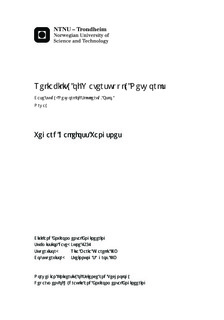| dc.description.abstract | It is necessary to have an understanding of the reliability of water distribution network, in order to make right decisions on maintenance and expansion of an existing network. The purpose of the master thesis has been to find a method of assessing/estimating the reliability of a water distribution network. Reliability of a water distribution network can be regarded by the mechanical reliability of the components, and/or the networks ability to deliver water to recipients at a sufficient pressure, at both normal and failure situations. The later is hydraulic reliability of the network, and this has been the focus of this report. This report has focused on methods of measuring a water distribution networks ability to perform its required function, for mechanical failure events. There are two ways of regarding the hydraulic reliability of a network, one way is to preform impact calculations for the network and then regard average impacts as well as impact distribution and maximum and minimum impacts. The other way is to use the impact and combine the mechanical reliability of the components. The first way is regarded as assessment of the reliability, while the second method is estimation of reliability. When estimating the reliability of a network, it is necessary to use time intervals in order to get a good perspective. The report contains a suggested method for determining the reliability of water distribution networks for different time-spans, based on failure probabilities and impact assessments. The method that is suggested contains 10 steps, whereof 6 are considered necessary. The method has been tested using a skeletonized version of the actual network of Skullerud in Oslo, Norway as a case study. The case network was provided by the municipality of Oslo, and no changes have been made by the student. Failure rates for the network have been made from registered failures in the network of Oslo, for the period of 1975-2011. The impact calculations were done with two different software solutions, with varying degree of consistency between the different calculations. In addition the report also contains a short comparison of demand and pressure driven analysis, and how they impact results for supply criticality. It has not been found any clear indication of demand driven or pressure driven analysis, has in general a higher or lower impact on hydraulic criticality. There are large differences between how consistent the results are. Values for valves and pumps are quite consistent, while pipes are more varying. This is based on the case study. With regards to the case study, the method indicates that the network of Skullerud can be considered to be both mechanically and hydraulically reliable, and that the expected loss off supply for the network is less than 2%, given a single failure event. The expected number of failures for the network within a month is 4, with the majority having a low impact on the network hydraulics. | nb_NO |

